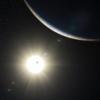

| Visitors Now: | |
| Total Visits: | |
| Total Stories: |

By Extinction Protocol: 2012 Earthchanges and News Event (Reporter)
Contributor profile | More stories
Contributor profile | More stories
| Story Views | |
| Now: | |
| Last Hour: | |
| Last 24 Hours: | |
| Total: | |
Massive changes to seafloor seen from July eruption of underwater volcano near Kermadec
Saturday, October 27, 2012 0:30
% of readers think this story is Fact. Add your two cents.
 October 27, 2012 – NEW ZEALAND - New Zealand scientists investigating an active undersea volcano that erupted three months ago have discovered significant changes to the seafloor. Niwa research ship Tangaroa has mapped the Kermadec volcano that erupted 800km northeast of Tauranga on July 19, producing a pumice raft the size of Canterbury. The eruption was strong enough to breach the ocean surface from a depth of 1100 meters. It was captured by a Nasa satellite, and a Royal New Zealand Air Force Orion patrol spotted the pumice on their way back home from Samoa. Niwa’s volcanologist Dr Richard Wysoczanski, who is leading the 23-day expedition, said there had been volcanic activity every year for the past decade, but this was the largest by far. “It is a substantial eruption. Had it occurred on land in New Zealand, it would have been a bit of a disaster.” The volcanic caldera, which is like Lake Taupo, known to produce large and violent eruptions, spewed up to 10,000 more material than the Mt Tongariro eruption on August 6, he said. It was mapped in 2002, showing a 1km-high undersea mountain with a 5km wide, 800-metre deep central crater. This week, scientists found a new volcanic cone which has formed on the edge of the volcano, towering 240 meters above the crater rim. They also found one side of the caldera wall is bulging in towards the volcano’s centre, indicating where an eruption may occur in the future or it may lead to an undersea avalanche. Several cubic kilometers of new material has also been added to the volcano, with large volumes of freshly erupted pumice accumulating on the caldera floor, raising it by up to 10 meters. “We couldn’t find any biology on the floor and the immediate vicinity has been completely wiped out,” Wysoczanski said. Fresh volcanic rocks, up to beach ball size, will be brought back to Niwa for analysis. Tangaroa embarked on the expedition to study the volcanic chain that stretches for 1000km north from Bay of Plenty. It is due back in Wellington on November 1. –Stuff
October 27, 2012 – NEW ZEALAND - New Zealand scientists investigating an active undersea volcano that erupted three months ago have discovered significant changes to the seafloor. Niwa research ship Tangaroa has mapped the Kermadec volcano that erupted 800km northeast of Tauranga on July 19, producing a pumice raft the size of Canterbury. The eruption was strong enough to breach the ocean surface from a depth of 1100 meters. It was captured by a Nasa satellite, and a Royal New Zealand Air Force Orion patrol spotted the pumice on their way back home from Samoa. Niwa’s volcanologist Dr Richard Wysoczanski, who is leading the 23-day expedition, said there had been volcanic activity every year for the past decade, but this was the largest by far. “It is a substantial eruption. Had it occurred on land in New Zealand, it would have been a bit of a disaster.” The volcanic caldera, which is like Lake Taupo, known to produce large and violent eruptions, spewed up to 10,000 more material than the Mt Tongariro eruption on August 6, he said. It was mapped in 2002, showing a 1km-high undersea mountain with a 5km wide, 800-metre deep central crater. This week, scientists found a new volcanic cone which has formed on the edge of the volcano, towering 240 meters above the crater rim. They also found one side of the caldera wall is bulging in towards the volcano’s centre, indicating where an eruption may occur in the future or it may lead to an undersea avalanche. Several cubic kilometers of new material has also been added to the volcano, with large volumes of freshly erupted pumice accumulating on the caldera floor, raising it by up to 10 meters. “We couldn’t find any biology on the floor and the immediate vicinity has been completely wiped out,” Wysoczanski said. Fresh volcanic rocks, up to beach ball size, will be brought back to Niwa for analysis. Tangaroa embarked on the expedition to study the volcanic chain that stretches for 1000km north from Bay of Plenty. It is due back in Wellington on November 1. –Stuff
2012-10-27 00:20:15
Source:


